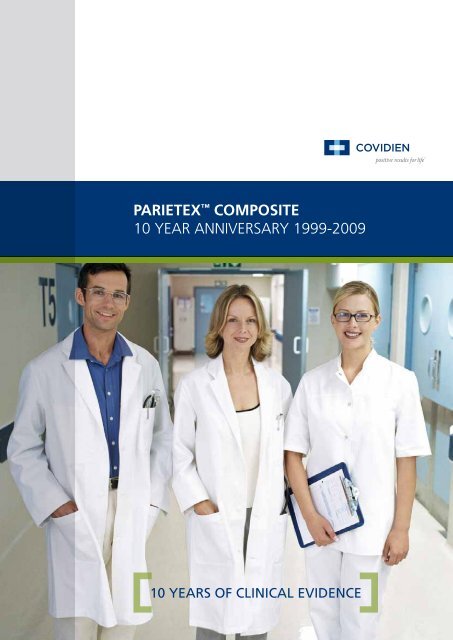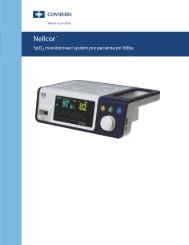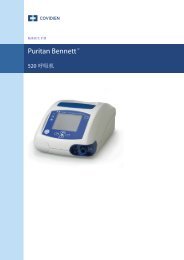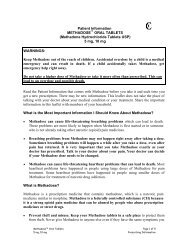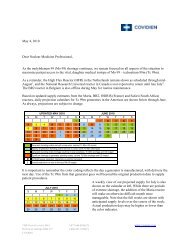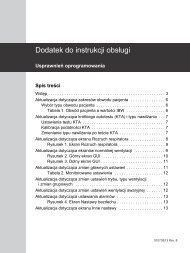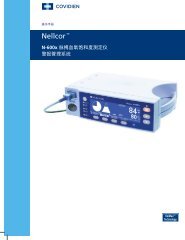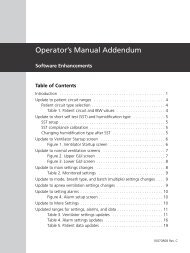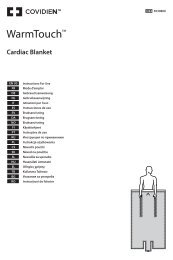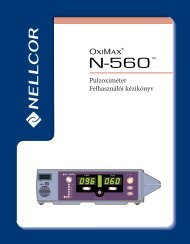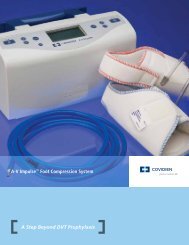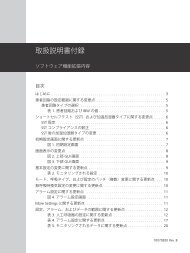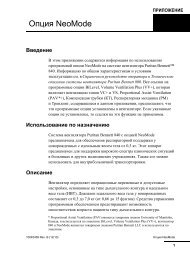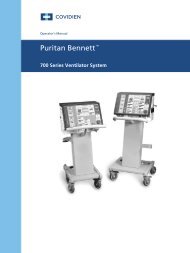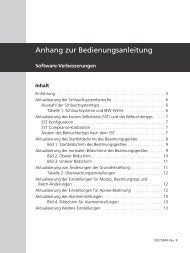Study 2 - Covidien
Study 2 - Covidien
Study 2 - Covidien
Create successful ePaper yourself
Turn your PDF publications into a flip-book with our unique Google optimized e-Paper software.
PARIETEX COMPOSITE<br />
10 YEAR ANNIVERSARY 1999-2009<br />
10 YEARS OF CLINICAL EVIDENCE
THE CONCEPT<br />
Polyester mesh takes on the challenge of<br />
hernia repair with material and manufacturing<br />
innovations to optimize healing and comfort<br />
through fast and intimate tissue in-growth. The<br />
new architecture of hernia repair features an<br />
enhanced hydrophilic, multi-filament construct<br />
and optimal porosity. Studies show that<br />
polyester is superior to other materials, such as<br />
polypropylene and ePTFE, in lack of shrinkage,<br />
advanced rate of healing and improved patient<br />
comfort.<br />
Optimized Material - hydrophilic polyester<br />
enhances rapid tissue in-growth rapid and<br />
complete tissue integration is an important<br />
requirement for an optimal hernia repair mesh 1 .<br />
To answer this need, our technology begins with<br />
a material difference — polyester. When this<br />
material is designed with optimum pore size<br />
it enhances fast and intimate tissue ingrowth.<br />
Polyester promotes the attraction, fixation and<br />
survival of young fibroblasts and mesothelial<br />
cells due to its hydrophilic nature. In contrast,<br />
polypropylene and ePTFE tend to repel all<br />
cells and avoid the fixation of all living cells<br />
to the material because of their hydrophobic<br />
characteristic. When a hydrophobic material<br />
like polypropylene, which do not promote the<br />
attraction of cells, is combined with a small-pore,<br />
size a common result is encapsulation of the<br />
mesh with scar tissue.<br />
Optimized Structure – porosity promotes<br />
connective tissue differentiation. To allow fast<br />
and intimate tissue in-growth without any<br />
peripheral fibrous capsule (which can cause<br />
shrinkage, discomfort and chronic pain), a<br />
mesh must also have porosities that are as large<br />
as possible 5 .Pore sizes below 1 mm trigger an<br />
intense inflammatory response. Inflammation<br />
and scar formation lead directly to encapsulation<br />
which in turn leads to contraction.<br />
Parietex technology creates both micropores for<br />
optimized cellular in-growth between the fibers<br />
and large macropores for true connective tissue<br />
differentiation. Parietex’s porosity allows the<br />
right amount of connective tissue in-growth with<br />
no fibrotic encapsulation or degradation.<br />
Preventing Visceral Attachments<br />
Intraperitoneal placement of the mesh represents<br />
a real advance in the ventral hernia repair:<br />
it facilitates laparoscopic treatment of small<br />
incisional hernia repair. The result is a reduction<br />
of operative time that benefits the patient by<br />
decreasing of surgical and anesthetic morbidity.<br />
When placing a mesh intraperitoneally it must<br />
provide a permanent or temporary interface<br />
between normally separated structures.<br />
The requirements for an ideal mesh are:<br />
• To physically separate anatomical structures<br />
during the early healing phase<br />
• To induce a minimized inflammatory response<br />
in order to reduce both encapsulation and<br />
adhesions to the barrier itself<br />
• To restore normal cleavage plans<br />
Parietex Composite (PCO) Mesh is composed<br />
of three-dimensional polyester structure on the<br />
parietal side and an absorbable collagen film on<br />
the visceral side.
PCO Series<br />
(Laparoscopy Surgery)<br />
A proprietary manufacturing<br />
process creates a strong link<br />
between the film and the<br />
threedimensional polyester<br />
structure (picture 1) which<br />
eliminates the risk of<br />
delamination that has been<br />
reported in other meshes.<br />
PCO OS Series<br />
(Open Surgery)<br />
Picture 1.<br />
The continuous, smooth, hydrophilic and<br />
resorbable collagen film is composed of a<br />
mixture of oxidized atelocollagen type I,<br />
polyethylene glycol and glycerol.<br />
The hydrogel film’s physico-chemical properties:<br />
hydrophilicity, elasticity and transparency<br />
make it easy for surgeons to implant the mesh<br />
intraperitoneally. Moreover, the film extends 5<br />
mm over the mesh edges providing additional<br />
protection.<br />
Parietex Composite (PCO) Mesh provides a<br />
temporary barrier and the film’s hydrophilicity<br />
promotes the attraction of mesothelial cells.<br />
After absorption it leaves a neo-peritoneum<br />
composed by mesothelial cells that will prevent<br />
visceral attachments.<br />
Parietex Composite<br />
Hiatal Mesh<br />
Parietex Composite<br />
Parastomal Mesh<br />
Before resorption of the hydrogelic film<br />
Hydrogelic<br />
film<br />
Mesh<br />
superficial<br />
thread<br />
Mesh deep<br />
thread<br />
Abdominal<br />
wall<br />
Transversal section 1 week after implantation<br />
After resorption of the hydrogelic film<br />
Mesh<br />
superficial<br />
thread<br />
Mesh deep<br />
thread<br />
Abdominal<br />
wall<br />
Transversal section 6 weeks after implantation<br />
Neoformed<br />
mesothelial<br />
layer<br />
Continuous<br />
neoperitoneum<br />
Differentiated<br />
tissue in-growth<br />
Intimate<br />
attachment<br />
of the mesh<br />
to the wall
CLINICAL RESULTS<br />
An optimal balance of properties backed the largest portfolio of clinical studies.<br />
<strong>Study</strong> # Adhesion Integration Shrinkage Degradation Pain Infection Elasticity<br />
Balique 1 X X X<br />
Chelala 2 X X X<br />
Burger 3 X X<br />
Jacob 4 X X X<br />
Duffy 5 X X<br />
McGinty 6 X X X<br />
Clavé 7 X<br />
Bracco 8 X<br />
Ramshaw 9 X<br />
Junge 10 X X<br />
Gonzales 11 X<br />
Schreinemacher 12 X X<br />
Köckerling 13 X X<br />
Junge 14 X X X<br />
Rosen 15 X<br />
ADHESION PREVENTION<br />
<strong>Study</strong> 1.<br />
80 patients were included in this prospective<br />
multicenter clinical trial. The main objective<br />
was to evaluate the antiadhesive properties of<br />
Parietex Composite (PCO) Mesh. Ultrasound<br />
(US) specific examinations of intestinal<br />
movement was initially validated (pre-operative<br />
prediction vs. Preoperative findings) and then<br />
used during the followup.<br />
Results<br />
After 12 months, 86% of the patients were<br />
ultrasonically adhesion free.<br />
• There was 0% occlusion and fistula.<br />
• Late complications were: mesh sepsis (1%),<br />
new defects (4%) and recurrence (2.5%).<br />
• At four years, 56 patients (75.7%) were clinically<br />
evaluated with a mean follow-up of 48±6 months.<br />
• One direct recurrence was noted while six patients<br />
experienced new defect outside the mesh.<br />
No long-term severe complication such as<br />
occlusion or enterocutaneous fistula was observed.<br />
<strong>Study</strong> 2.<br />
In this retrospective study, the author evaluated<br />
a minimally invasive surgical technique of<br />
moderate to large incisional and ventral hernia<br />
defects using Parietex Composite (PCO)<br />
Mesh. The midterm results for 400 patients are<br />
presented in terms of efficacy and safety.<br />
Results<br />
• On 400 patients, no major complications<br />
were observed, 0 small bowel obstruction,<br />
0 enterocutaneaous fistula and 0 infections.<br />
• A second look study (for other indications) was<br />
performed on 35 patients (8.75%) 3 to 13 months<br />
postoperatively that confirms the global results.<br />
• The majority (23 patients, 65.71%) were adhesion<br />
free.<br />
• Some had loose adhesions of the omentum<br />
(grade 1 of Mueller’s classification; n = 10), and<br />
the remainder had easily cleavable serosal adhesions<br />
(grade 2 of Mueller’s classification; n = 2)<br />
• There were no cases of chronic infection, small<br />
bowel obstruction, fistula, or hernia fistula, and<br />
no conversions occurred in this study.
<strong>Study</strong> 3<br />
In an experimental rat study, the authors<br />
wanted to evaluate adhesion formation with<br />
different types of currently available composite<br />
meshes. Eight different meshes were placed<br />
intraperitoneally and in direct contact with<br />
abdominal viscera in 200 rats.<br />
The following meshes were tested: polypropylene<br />
(Ethicon's Prolene*), ePTFE (Gore's Dualmesh<br />
®), polypropylene– polyglecaprone composite<br />
(Ethicon's Ultrapro*), titanium–polypropylene<br />
composite (GfE's Timesh®), polypropylene with<br />
carboxymethylcellulose–sodium hyaluronate<br />
coating (Bard* Sepramesh*), polyester with<br />
collagen-polyethylene glycol–glycerol coating<br />
(Parietex Composite), polypropylene–<br />
polydioxanone composite with oxidized cellulose<br />
coating (Ethicon's Proceed), and bovine<br />
pericardium (Tutogen Medical's Tutomesh®).<br />
Adhesion formation, mesh incorporation, tensile<br />
strength, shrinkage, and infection were evaluated<br />
at 7 days and 30 days.<br />
Results<br />
• At 7 days and 30 days, Parietex Composite<br />
resulted in significantly less adhesions (3.9% and<br />
11.2% respectively) than observed with other<br />
meshes except Tutogen Medical's Tutomesh® and<br />
Bard* Sepramesh*<br />
Duamesh<br />
Timesh<br />
Ultrapro<br />
Prolene<br />
Proceed<br />
Sepramesh<br />
PCO<br />
Tutomesh<br />
<strong>Study</strong> 4.<br />
Adhesion surface at 30 days<br />
0 10 20 30 40 50 60<br />
This prospective, randomized animal study<br />
compared shrinkage, adhesions and tissue<br />
ingrowth between Parietex Composite (PCO)<br />
Mesh, Ethicon's Proceed and uncoated<br />
polypropylene. 3 different 10x15 meshes were<br />
implanted in 10 pigs and then evaluated after<br />
28 days.<br />
• The mean area of adhesions to Parietex<br />
Composite (PCO) Mesh (11%) was significantly<br />
less than for Ethicon's Proceed (48%; p< 0.008)<br />
or PPM (46%;p < 0.008)<br />
%<br />
• Adhesion peel strength was significantly less for<br />
PCO (5.9 N) than for Ethicon's Proceed (12.1 N;<br />
p < 0.02) or PPM (12.9 N; p < 0.02)<br />
60%<br />
50%<br />
40%<br />
30%<br />
20%<br />
10%<br />
0%<br />
<strong>Study</strong> 5.<br />
In this prospective animal study Parietex<br />
Composite (PCO) Mesh and Bard's Composix®<br />
E/X (Bard) were implanted in female Yorkshire<br />
swine and evaluated in terms of adhesion and<br />
tissue integration. The meshes were analyzed<br />
at 28 days post implantation by a veterinary<br />
pathologist who was blinded to the data.<br />
Results<br />
• At 28 days, PCO induced fewer adhesions than<br />
ePTFE mesh (14.5% vs 53.4%, P=0.007).<br />
• On an adhesion scale (0–5), we had 1.75 for PCO<br />
(P
Results<br />
• After 21 days, adhesion formation was evaluated<br />
and Parietex Composite exhibited the lowest<br />
rate of adhesions with 8.3%, with non significance<br />
difference with other meshes except for<br />
Sepramesh and the untreated mesh.<br />
Untreated Parietene<br />
Control<br />
Sepramesh<br />
Gore-Tex Dual Mesh<br />
Bard Composix E/X<br />
Parietene composite<br />
Parietex composite<br />
<strong>Study</strong> 12<br />
Adhesion rate in %<br />
0 10 20 30 40 50 60 70 80 90 100<br />
Comparison of adhesion formation between mesh products.<br />
Adhesion rate (%)<br />
This study examined the ability of different<br />
coated and uncoated meshes to attenuate<br />
adhesion formation.<br />
6 meshes were placed intraperitoneally in<br />
rats: Ethicon's Prolene* (polypropylene),<br />
GfE's Timesh® (polypropylene with titanium),<br />
Ethicon's Ultrapro<br />
(polypropylene composites with polyglecaprone),<br />
Ethicon's Proceed (polypropylene mesh coated<br />
with a layer of cellulose) and Parietex Composite<br />
and Atrium's C-QUR (polypropylene mesh<br />
coated with a layer of omega-3 fatty acids).<br />
Adhesions and incorporation were evaluated<br />
macroscopically and microscopically after 7<br />
and 30 days.<br />
%<br />
Results<br />
• Parietex Composite (PCO) and Atrium's<br />
C-QUR showed the lowest score of adhesion<br />
compared to the other meshes with statistical<br />
difference.<br />
• Only Parietex Composite (PCO) showed no<br />
visceral adhesions at 30 days.<br />
<strong>Study</strong> 13<br />
3 different composite meshes were<br />
laparoscopically implanted in six swine (FEG's<br />
Dynamesh® IPOM, Ethicon's Proceed,<br />
Parietene Composite). Parietene Composite<br />
has the same antiadhesive film than Parietex<br />
Composite.<br />
After 4 months, adhesion incidence and<br />
adhesion coverage were measured.<br />
Results<br />
• Adhesion values were 12.8% for Parietene<br />
Composite, 31.7% for Ethicon's Proceed and<br />
33.2% for Dynamesh IPOM (p = 0.01).<br />
<strong>Study</strong> 14<br />
4 differents meshes PVDF+PP (FEG's<br />
Dynamesh®), PP+Col (Parietene Composite),<br />
ePTFE (Dual mesh) and PP (a pure<br />
polypropylene mesh serving as control) were<br />
implanted in 40 rats. Parietene Composite<br />
has the same antiadhesive film than Parietex<br />
Composite.<br />
Adhesion rate, tissue integration and shrinkage<br />
were evaluated after 30 days.<br />
Results<br />
• Parietene Composite (PCO) adhesion rate<br />
was (26.8 ± 12.1%) and the PVDF+PP mesh<br />
(34.6 ± 8.2%).
TISSUE INTEGRATION<br />
<strong>Study</strong> 3<br />
• Parietex Composite (PCO) showed at 7 days<br />
and 30 days the highest tissue incorporation.<br />
• Parietex Composite (PCO) showed the highest<br />
tensile strength (14.2 N)<br />
Tutomesh<br />
Dualmesh<br />
Timesh<br />
Prolene<br />
Proceed<br />
Ultrapro<br />
Sepramesh<br />
PCO<br />
Tensile strengh<br />
0 2 4 6 8 10 12 14 16<br />
Newton<br />
<strong>Study</strong> 4<br />
• Peak peel strength from the abdominal wall was<br />
significantly higher for PCO (17.2 N) than for<br />
Ethicon's Proceed (10.7 N) or PPM (10 N; p <<br />
0.002)<br />
<strong>Study</strong> 5<br />
• Good tissue ingrowth and neovascularisation had<br />
been observed in both meshes, although PCO<br />
showed a more complete neoperitoneum.<br />
<strong>Study</strong> 6<br />
• Peel strength of mesh from the abdominal wall<br />
was greater for PCO (2.8 N/cm, p = 0.001) or<br />
• PPM (2.1 N/cm, p = 0.05) than for ePTFE<br />
(1.3N/cm of mesh width).
SHRINKAGE<br />
<strong>Study</strong> 2<br />
• Based on the 2 nd look study (35 patients) the<br />
author noted the absence of prosthesis shrinking<br />
and wrinkling in all these cases confirming its<br />
total peritonization on the anterior abdominal<br />
wall.<br />
<strong>Study</strong> 3<br />
• Parietex Composite (PCO) showed 15.3% at<br />
30 days with no significant difference with other<br />
mesh but Tutogen Medical's Tutomesh® (44.3%)<br />
<strong>Study</strong> 4<br />
The area of each mesh at the time of insertion<br />
was 150 cm 2 .<br />
• PCO (105.8 cm², 29.5%) had less shrinkage than<br />
Ethicon's Proceed (99.6 cm², 33.6%) but with<br />
no statistically significant difference.<br />
<strong>Study</strong> 6<br />
The area of each mesh at the time of insertion<br />
was 150 cm 2 .<br />
• ePTFE (94.4 cm 2 , 63% of original area)<br />
• PCO (118.6 cm 2 , 79% of original area, p = 0.001)<br />
• PPM (140.7 cm 2 , 94% of original area, p = 0.002).<br />
<strong>Study</strong> 13<br />
Parietene Composite and FEG's Dynamesh®<br />
IPOM had a similar value of 14% of shrinkage<br />
while Ethicon's Proceed showed a 25%<br />
reduction in its surface area.<br />
<strong>Study</strong> 14<br />
• Parietene Composite (PCO) and FEG's<br />
Dynamesh® IPOM had a similar value of 19%<br />
of shrinkage while Dual mesh showed a 52%<br />
reduction in its surface area.
ELASTICITY<br />
<strong>Study</strong> 10<br />
The study showed that at a strain of 16N new<br />
ideal meshes should show an elasticity of at least<br />
25% in vertical stretching and 15% in horizontal<br />
stretching to achieve almost physiological<br />
properties.<br />
The graphs below show the physiologic elasticity<br />
band and the elasticity of several meshes.<br />
Parietex and Parietene Composite are above<br />
the minimum requirement and don’t impair the<br />
physiological abdominal wall elasticity.<br />
Relative distension (%)<br />
Relative distension (%)<br />
70<br />
60<br />
50<br />
40<br />
30<br />
20<br />
10<br />
Vertical direction<br />
0<br />
0 2 4 6 8 10 12 14 16 18 20 22 24<br />
70<br />
60<br />
50<br />
40<br />
30<br />
20<br />
10<br />
Horizontal direction<br />
0<br />
0 2 4 6 8 10 12 14 16 18 20 22 24<br />
Tensile strengh (N)<br />
3D PET (Parietex ® Composite)<br />
3D PP (Parietene ® Composite)<br />
2D Light weight PP<br />
(Parietex ® Light)<br />
2D Heavy weight PP (Prolene ® )
DEGRADATION<br />
<strong>Study</strong> 7<br />
The objective of the study was to compare the<br />
state of alteration of different meshes commonly<br />
used in Pelvic Floor Disorder surgery.<br />
Multicentric retrospective and comparative<br />
study of 100 explanted samples of different<br />
meshes: Low Density polypropylene mesh<br />
(LDPPMF), High Density polypropylene<br />
(HDPPMF), Polypropylene Multifilament, Non-<br />
Knotting Non-Woven Polypropylene (NKNW),<br />
Polypropylene-polyglactin acid (Composite),<br />
Polyethylene Terephtalate (PET).<br />
Scanning Electron Microscopy (SEM) analysis<br />
was performed on each explanted meshes.<br />
SEM analysis has shown 39% of impaired<br />
meshes. All Polypropylene meshes 44.5%:<br />
LDPPMF 21%<br />
HDPPMF 47.8%<br />
Multifilament 75%<br />
Composite 87.5%<br />
NKNW 100%<br />
PET 0%<br />
<strong>Study</strong> 8<br />
SEM analysis was performed on 25 explanted<br />
meshes after primary abdominal wall hernia<br />
repair.<br />
The average period of implant was 32.5 months<br />
(range 2–180)<br />
Results<br />
• 100% of PP meshes (2 to 52 months of<br />
implantation) showed alterations<br />
• 0% of PET meshes (36 to 180 months<br />
of implantation) showed alteration.<br />
PP mesh<br />
PP mesh<br />
PET mesh<br />
Fig. 1 Scanning electron microscopy (SEM)<br />
micrograph (1,000x) of fragment #24<br />
polyethylene terephthalate (PET)<br />
Fig. 2 Scanning electron microscopy (SEM)<br />
micrograph (1,000x) of fragment #20<br />
polyethylene (PP)
<strong>Study</strong> 9<br />
14 Polypropylene meshes were removed from<br />
patients requiring revision surgery due to<br />
chronic pain, recurrence, infection, adhesions,<br />
or other complications.<br />
PAIN<br />
<strong>Study</strong> 1<br />
• Pain was reduced to a very low level:<br />
0.2±0.8/10 in the open group and 0.8±1.6/10 in<br />
the laparoscopic group.<br />
• 69% of the patients were totally pain free<br />
(VAS= 0) in the open group and 67% in<br />
the laparoscopic group.<br />
INFECTION<br />
<strong>Study</strong> 1<br />
• 1 mesh sepsis (1%) occurred at 8 months after<br />
a series of events on the incision, but it was not<br />
related directly to the mesh.<br />
<strong>Study</strong> 2<br />
• 1 mesh sepsis after day 3 requiring mesh<br />
explantation (0.25%).<br />
• No chronic infection reported.<br />
<strong>Study</strong> 15<br />
This retrospective human study was designed<br />
to assess postoperative infections, fistulas,<br />
small-bowel obstructions and recurrence rates<br />
using Parietex Composite (PCO) Mesh in a<br />
complex group of patients. 109 patients had<br />
ventral hernias repaired and were tracked for a<br />
year. Forty-two (42%) of the patients were being<br />
treated for a recurrent hernia and twenty-six<br />
(26%) had prior intraperitoneal mesh placement.<br />
Results<br />
• 85% of the explanted meshes showed alterations<br />
of their surface (cracks, fissures, and increased<br />
surface roughness).<br />
• Moreover, nearly all meshes showed a decrease<br />
of the compliance (from 4 to 30 times more force<br />
to fold the mesh than the pristine mesh)<br />
<strong>Study</strong> 2<br />
• Transient pain was experienced by 10 patients<br />
(2.5%), and resolved over time with analgesic<br />
treatment.<br />
• After 28 months, 97.5% of our patients were<br />
pain free, residual chronic parietal pain was<br />
reported for 10 patients (2.5%)<br />
Results<br />
• In the laparoscopic group, there were no delayed<br />
mesh infections, fistulas or hernia recurrences<br />
during the 14 month follow-up period.<br />
• In the open group, there were no long term<br />
bowel obstructions, fistulas or delayed infections<br />
related to the mesh during the 11 month follow<br />
up period.<br />
• Dr Rosen concluded based on his experience<br />
with a follow up of approximately 1 year,<br />
there does not seem to be an increased risk<br />
of mesh infection, bowel obstructions, or<br />
enterocutaneous fistulas. Polyester mesh seems<br />
to be safe for ventral hernia repair.
Tyco Healthcare Pty Ltd<br />
166 Epping Road,<br />
Lane Cove NSW 2066<br />
Australia<br />
(t) 1800 252 467<br />
References<br />
1. Balique J.G. et al. Intraperitoneal treatment<br />
of incisional and umbilical hernias using an<br />
innovative composite mesh: 4 years results<br />
of a prospective multicenter clinical trial.<br />
Hernia 2005. 9: 68–74<br />
2. Chelala E et al. The suturing concept for<br />
laparoscopic mesh fixation in ventral and<br />
incisional hernia repair: a mid term analysis<br />
of 400 cases. Surgical Endoscopy, 2006<br />
3. Burger J.W.A et al. Evaluation of new prosthetic<br />
meshes for ventral hernia repair. Surgical<br />
Endoscopy, 2006. 20: 1320–1325<br />
4. B.P. Jacob et al. Tissue ingrowth and bowel<br />
adhesion formation in an animal comparative<br />
study: polypropylene versus Proceed versus<br />
Parietex Composite. Surgical Endoscopy<br />
2007, 21: 629–633<br />
5. Duffy AJ et al. Comparison of two composite<br />
meshes using two fixation devices in a porcine<br />
laparoscopic ventral hernia repair. Hernia<br />
2004;8 : 358-364<br />
6. McGinty J.J et al. A comparative study of<br />
adhesion formation and abdominal wall<br />
ingrowth after laparoscopic ventral hernia<br />
repair in a porcine model using multiple types<br />
of mesh. Surg Endosc (2005) 19: 786–790<br />
7. Clave´ A, et al. <strong>Study</strong> of the Alterations of<br />
100 Meshes Excised for Complications after<br />
Stress Urinary Incontinence or Pelvic Organ<br />
Prolapses Surgery. Journal of Minimally Invasive<br />
Gynecology 15 (2008) S1eS159<br />
8. P. Bracco et al. Comparison of polypropylene and<br />
polyethylene terephthalate (Dacron) meshes for<br />
abdominal wall hernia repair: A chemical and<br />
morphological study. Hernia (2005) 9: 51–55<br />
Tyco Healthcare Ltd<br />
Ground Floor, 15B Vestey Drive,<br />
Mount Wellington, Auckland<br />
New Zealand<br />
(t) 0508 489 264<br />
9. C.R. Costello, S.L. Bachman, B.J. Ramshaw, S.A.<br />
Grant. Materials Characterization of Explanted<br />
Polypropylene Hernia Meshes. Journal of<br />
Biomedical Materials Research Part B: Applied<br />
Biomaterials. 2007<br />
10. Junge K.et al.: Elasticity of the abdominal wall and<br />
impact for reparation of incisional repairs using<br />
mesh implants. Hernia 2001<br />
11. Gonzales et al. Resistance to adhesion formation:<br />
A comparative study of treated and untreated<br />
mesh products placed in the abdominal cavity.<br />
Hernia (2004) 8: 213–219<br />
12. M. H. F. Schreinemacher et al. Degradation of<br />
mesh coatings and intraperitoneal adhesion<br />
formation in an experimental model. British<br />
Journal of Surgery 2009; 96: 305–313<br />
13. Christine Schug-Pass, Florian Sommerer, Andrea<br />
Tannapfel, Hans Lippert, Ferdinand Köckerling.<br />
The use of composite meshes in laparoscopic<br />
repair of abdominal wall hernias: are there<br />
differences in biocompatibily? Surg Endosc, 2008<br />
14. Karsten Junge et al. Adhesion formation of a<br />
polyvinylidenfluoride/polypropylene mesh for<br />
intra-abdominal placement in a rodent animal<br />
model. Surg Endosc 2008<br />
15. Michael J Rosen. Polyester-based mesh for ventral<br />
hernia repair: is it safe? The American Journal of<br />
Surgery (2009) 197, 353-359.<br />
COVIDIEN, COVIDIEN with logo and marked brands<br />
are trademarks of <strong>Covidien</strong> AG or its affiliate.<br />
© 2010 <strong>Covidien</strong> AG or its affiliate. All rights reserved.<br />
Hernia 031-07-10<br />
www.covidien.com


